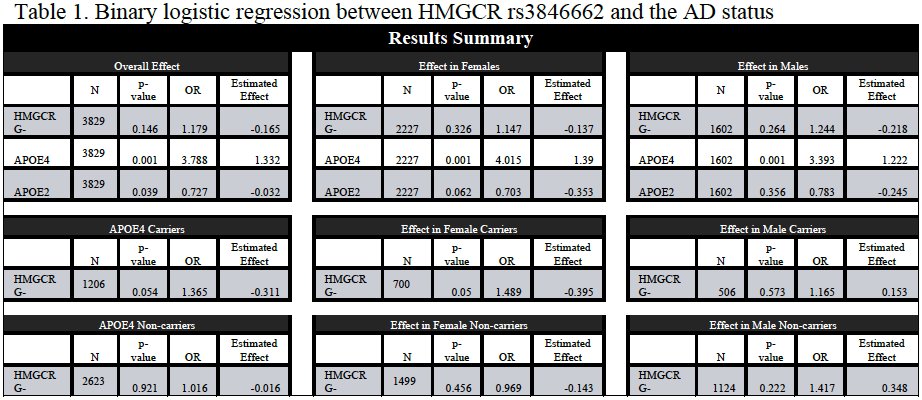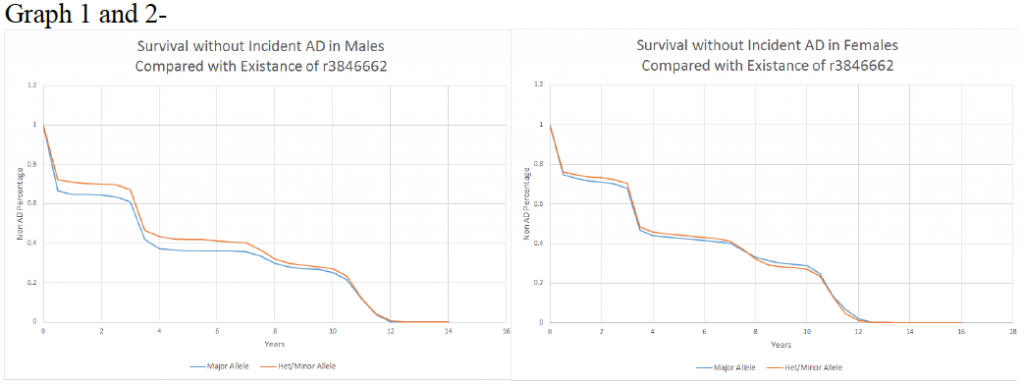Brian Davis and Dr. John S.K. Kauwe, Biology
Introduction
Alzheimer’s disease (AD) is a chronic neurodegenerative disorder that occurs predominantly later in life and represents the fourth most common cause of death in the developed world. Given the absence of curative treatment, discovering the factors related to the development of AD and the conversion from mild cognitive impairment (MCI) to AD is one of the most urgent medical mysteries affecting the aging population. The search for the identification of genes contributing to AD led to the identification of 695 candidate genes of which a surprising number are directly involved in lipid metabolism at the level of transport, synthesis, storage, and internalization of lipoproteins. Because 3-hydroxy-3methylglutaryl-CoA reductase (HMGCR) encodes for the enzyme that serves as the rate-limiting step in cholesterol synthesis, it is not surprising that recent studies have found an association between the HMGCR gene locus and AD. This association did not prove that HMGCR plays a role in AD, yet it does signal that studies analyzing the correlation between HMGCR and AD are needed. Our research focused on evaluating a single-nucleotide polymorphism (SNP) rs3846662 that has been reported to be involved in the regulation of HMGCR exon 13 skipping. Previous studies regarding rs3846662 state that subjects with the homozygous A (AA) allele exhibit a reduced risk of AD, a reduced conversion rate from MCI to AD, and a delayed age for onset of AD. Through genotyping the samples obtained through the Cache County Study on Memory, Health, and Aging and analyzing the data, we hope to confirm this report. Our project will further this study by analyzing more subgroups such as males with the G negative alleles, APOE4 positive alleles, and comparing the rate of decline after diagnosis of AD, survival rate, and the survival rate of males and female subgroups with different rs3846662 alleles.
Methodology
Dataset: We used DNA from the Cache County study on Memory, Health and Aging. All the participants were been screened for dementia and Alzheimer’s disease every three years beginning in 1995. This study consists of 5,092 samples from people in Cache County, Utah.
Genotyping: These samples were genotyped using using TaqMan primers and probes and standard quantitative PCR reaction using ViiA 7 qPCR machine in the Kauwe lab.
Statistical Analysis: We used binary logistic regression to analyze the relationship between HMGCR polymorphisms and disease status. These groups were stratified by gender and APOE genotype using Wald statistics. Odds ratios for HMGCR and APOE polymorphisms were also calculated. We also performed linear regression and survival analysis to analyze the HMGCR rs3846662’s effect on survival without incident AD in both females and males. All statistical analysis was performed using the R programming language.
Results
Our study showed little to no statistical significance for any correlation between HMGCR rs3846662 and AD status in the general population, females, or males. Only in female carriers of APOE4 did the homozygous A allele exhibit a statistically significant decreased risk of developing AD. (See table 1). Our survival analysis also showed no statistical significance or correlation between HMGCR rs3846662 and delayed incident AD. (see Graphs 1 and 2)
Discussion
While this study did not statistically show correlation between rs3846662 and AD status or show that rs3846662 acted as a protective variant, it does highlight the differences between the effect of certain genes in males and in females while also showing that under certain circumstances HMGCR can act as a modifier. With the knowledge that rs3846662 may not be as potent a modifier as previous studies have stated, more studies must be done to learn the effects of different HMGCR genotypes that may allow for protection. This understanding can help us learn how statins may effect and help decrease AD disease prevalence.
Conclusion
Though this study did not show any large statistically significant correlation between rs3846662 and AD, the results of previous studies, the results of numerous studies on the effect of statins, and our meager corollary evidence in females with APOE4 signal that the HMGCR gene and the use of statins can act as potent modifiers of AD.


